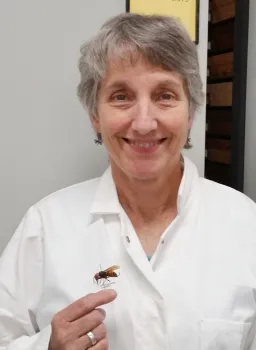Targeting the Asian Giant Hornet, aka Murder Hornet, and Now 'The Northern Giant Hornet'

The event is free and family friendly. It is the Bohart's first special event of the fall season.
Visitors will learn about the smallest fairy wasps to the "murder hornets"; what role wasps play in plant galls and figs; and how to distinguish a parasitoid from a parasite. Lynn Kimsey, director of the Bohart Museum and a UC Davis distinguished professor of entomology, will discuss the Asian giant hornet, Vespa mandarinia, dubbed by the news media as “the murder hornet." The Entomological Society of America recently established as its official common name, “northern giant hornet.”
A single colony of the Asian giant hornet was found and destroyed Sept. 18, 2019 in Nanaimo, Vancouver Island, Canada, and a single dead hornet was found Dec. 8, 2019 in nearby Blaine, Wash. Since then, it also has been sighted-- and destroyed--in both Canada and Washington state.
Kimsey, an authority on the giant hornet and a two-term past president of the International Society of Hymenopterist, says the insects probably "hitched a ride" in a cargo box shipped from Asia to a North American seaport. The insect is considered the world's largest species of hornet and can reach up to 2 inches in length. A few hornets can destroy a bee colony, decapitating the honey bees, in a matter of hours.
Kimsey and two other wasp experts published “The Diversity of Hornets in the Genus Vespa (Hymenoptera: Vespidae; Vespinae); Their Importance and Interceptions in the United States,” in the journal Insect Systematics and Diversity in May of 2020. (See https://bit.ly/3BVZ34Y)
Lead author Allan Smith-Pardo, U.S. Department of Agriculture Animal and Plant Health Inspection Service (APHIS), and co-authors James Carpenter of the American Museum of Natural History's Division of Invertebrate Zoology, and Kimsey covered 22 species of hornets, including V. mandarinia.
Fairy wasps, which belong to the family of chalcidoid wasps, are tiny insects that include the world's smallest known insect, with a body length of 0.139mm, and the smallest known flying insect, only 0.15mm. All known fairy wasps are parasitoids of the eggs of other insects.
A family arts-and-crafts activity is also planned at the open house.
The Bohart Museum is the home of a global collection of eight million insect specimens. It also houses a live “petting zoo,” comprised of Madagascar hissing cockroaches, stick insects and tarantulas; and a gift shop with insect-themed items. More information is available on the website at https://bohart.ucdavis.edu or by contacting bmuseum@ucdavis.edu.
